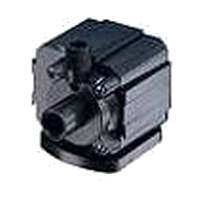
 POWERHEADS
- Their most common use is to provide extra water movement
within an aquarium. For Reef aquariums, this is vital since a great
many of the corals need a good deal more water flow than what can
usually be provided for by a sump's return line. A few powerheads
located strategically
will solve that problem. Due to their being easily moved, I find them
to be a good choice since I can direct the water flow as needed. Being
easily removed, also means they are easily cleaned. A very important
feature for me. The only down side that I see with their use is that
they can be very visible and may detract from the overall look of the
scenery. This can be solved by the creative use of rocks to hide them,
although in doing so, you should ensure such rocks can be moved out of
the way to allow access to the pump for cleaning and adjustments.
POWERHEADS
- Their most common use is to provide extra water movement
within an aquarium. For Reef aquariums, this is vital since a great
many of the corals need a good deal more water flow than what can
usually be provided for by a sump's return line. A few powerheads
located strategically
will solve that problem. Due to their being easily moved, I find them
to be a good choice since I can direct the water flow as needed. Being
easily removed, also means they are easily cleaned. A very important
feature for me. The only down side that I see with their use is that
they can be very visible and may detract from the overall look of the
scenery. This can be solved by the creative use of rocks to hide them,
although in doing so, you should ensure such rocks can be moved out of
the way to allow access to the pump for cleaning and adjustments.  SUBMERSIBLE PUMPS
- While very similar to powerheads in function, these pumps
generally provide a great more pumping capacity, vital when using
sumps or refugiums which are usually located well below the main
aquarium and any pump has to be able to send a usable amount of water
upwards. The submersible pumps are easier to install simply because
there is no need to drill a hole through the side of the sump or
refugium. This ease of use does come with a possible concern though.
Since the motor is underwater, it could add to the heating of your
aquarium's water. Which may or may not be a concern depending on your
individual temperature circumstances. Of course, another concern is of
having electrical motors and wiring being underwater. Any use of
submerged electrical equipment, including heaters, should have a nearby
GFI outlet to plug them into.
SUBMERSIBLE PUMPS
- While very similar to powerheads in function, these pumps
generally provide a great more pumping capacity, vital when using
sumps or refugiums which are usually located well below the main
aquarium and any pump has to be able to send a usable amount of water
upwards. The submersible pumps are easier to install simply because
there is no need to drill a hole through the side of the sump or
refugium. This ease of use does come with a possible concern though.
Since the motor is underwater, it could add to the heating of your
aquarium's water. Which may or may not be a concern depending on your
individual temperature circumstances. Of course, another concern is of
having electrical motors and wiring being underwater. Any use of
submerged electrical equipment, including heaters, should have a nearby
GFI outlet to plug them into.  NON-SUBMERSIBLE PUMPS
- By far, the best choice, in my opinion, to provide water
pumping capacity to your system. While the initial installment may be
more involved due to having holes and bulkhead fittings installed on
your sump and/or refugium, the capacity alone is worth the extra
effort. Another big benefit of their use is that any heat generated by
the motor will not heat your water as well as not having electrical
components sitting underwater creating a possible shock hazard.
NON-SUBMERSIBLE PUMPS
- By far, the best choice, in my opinion, to provide water
pumping capacity to your system. While the initial installment may be
more involved due to having holes and bulkhead fittings installed on
your sump and/or refugium, the capacity alone is worth the extra
effort. Another big benefit of their use is that any heat generated by
the motor will not heat your water as well as not having electrical
components sitting underwater creating a possible shock hazard.  AIR PUMPS
- A staple in providing aeration to our aquarium water,
while not in great use in larger reef aquariums, they do have their
place in use with smaller aquariums when sumps or submersible water
pumps are not feasible. The only concern in their use is the spray of
water that a great many bubbles can create, this can be controlled by
the use of my air stone bubble trap. Also, if you have to place the air
pump below the tanks surface water level, be sure to install a one way
valve on the air line to prevent water back siphoning into the air pump
during power outages.
AIR PUMPS
- A staple in providing aeration to our aquarium water,
while not in great use in larger reef aquariums, they do have their
place in use with smaller aquariums when sumps or submersible water
pumps are not feasible. The only concern in their use is the spray of
water that a great many bubbles can create, this can be controlled by
the use of my air stone bubble trap. Also, if you have to place the air
pump below the tanks surface water level, be sure to install a one way
valve on the air line to prevent water back siphoning into the air pump
during power outages.